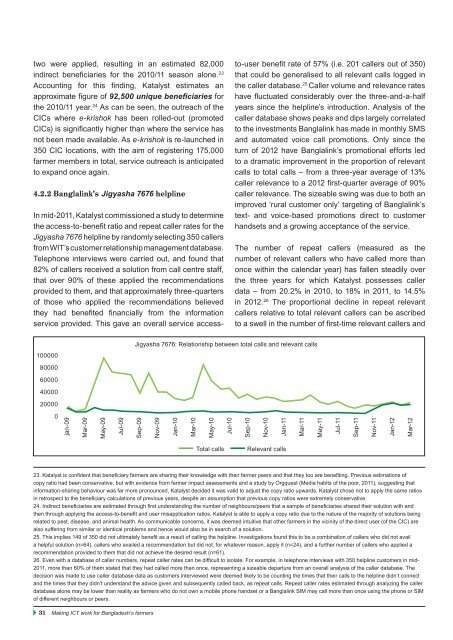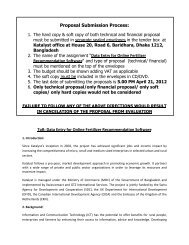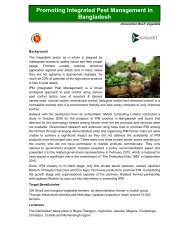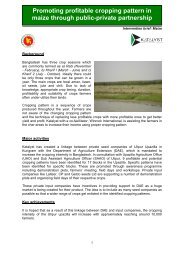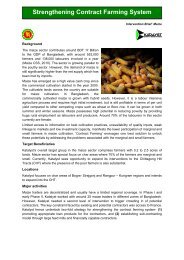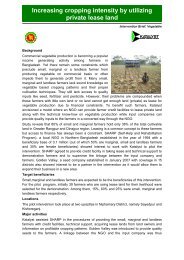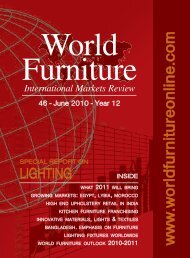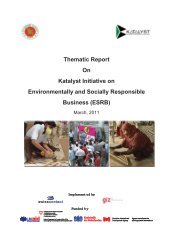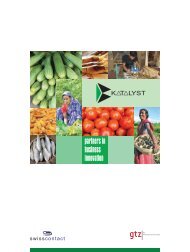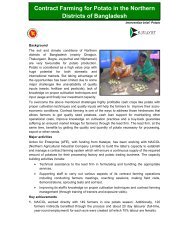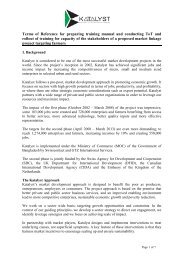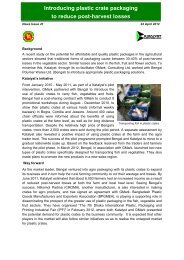Making ICT work for Bangladesh's farmers - Katalyst
Making ICT work for Bangladesh's farmers - Katalyst
Making ICT work for Bangladesh's farmers - Katalyst
Create successful ePaper yourself
Turn your PDF publications into a flip-book with our unique Google optimized e-Paper software.
two were applied, resulting in an estimated 82,000<br />
indirect beneficiaries <strong>for</strong> the 2010/11 season alone. 23<br />
Accounting <strong>for</strong> this finding, <strong>Katalyst</strong> estimates an<br />
approximate figure of 92,500 unique beneficiaries <strong>for</strong><br />
the 2010/11 year. 24 As can be seen, the outreach of the<br />
CICs where e-krishok has been rolled-out (promoted<br />
CICs) is significantly higher than where the service has<br />
not been made available. As e-krishok is re-launched in<br />
350 CIC locations, with the aim of registering 175,000<br />
farmer members in total, service outreach is anticipated<br />
to expand once again.<br />
4.2.2 Banglalink’s Jigyasha 7676 helpline<br />
In mid-2011, <strong>Katalyst</strong> commissioned a study to determine<br />
the access-to-benefit ratio and repeat caller rates <strong>for</strong> the<br />
Jigyasha 7676 helpline by randomly selecting 350 callers<br />
from WIT’s customer relationship management database.<br />
Telephone interviews were carried out, and found that<br />
82% of callers received a solution from call centre staff,<br />
that over 90% of these applied the recommendations<br />
provided to them, and that approximately three-quarters<br />
of those who applied the recommendations believed<br />
they had benefited financially from the in<strong>for</strong>mation<br />
service provided. This gave an overall service accessto-user<br />
benefit rate of 57% (i.e. 201 callers out of 350)<br />
that could be generalised to all relevant calls logged in<br />
the caller database. 25 Caller volume and relevance rates<br />
have fluctuated considerably over the three-and-a-half<br />
years since the helpline’s introduction. Analysis of the<br />
caller database shows peaks and dips largely correlated<br />
to the investments Banglalink has made in monthly SMS<br />
and automated voice call promotions. Only since the<br />
turn of 2012 have Banglalink’s promotional ef<strong>for</strong>ts led<br />
to a dramatic improvement in the proportion of relevant<br />
calls to total calls – from a three-year average of 13%<br />
caller relevance to a 2012 first-quarter average of 90%<br />
caller relevance. The sizeable swing was due to both an<br />
improved ‘rural customer only’ targeting of Banglalink’s<br />
text- and voice-based promotions direct to customer<br />
handsets and a growing acceptance of the service.<br />
The number of repeat callers (measured as the<br />
number of relevant callers who have called more than<br />
once within the calendar year) has fallen steadily over<br />
the three years <strong>for</strong> which <strong>Katalyst</strong> possesses caller<br />
data – from 20.2% in 2010, to 18% in 2011, to 14.5%<br />
in 2012. 26 The proportional decline in repeat relevant<br />
callers relative to total relevant callers can be ascribed<br />
to a swell in the number of first-time relevant callers and<br />
Jigyasha 7676: Relationship between total calls and relevant calls<br />
100000<br />
80000<br />
60000<br />
40000<br />
20000<br />
0<br />
jan-09<br />
Mar-09<br />
May-09<br />
Jul-09<br />
Sep-09<br />
Nov-09<br />
Jan-10<br />
Mar-10<br />
May-10<br />
Jul-10<br />
Sep-10<br />
Nov-10<br />
Jan-11<br />
Mar-11<br />
May-11<br />
Jul-11<br />
Sep-11<br />
Nov-11<br />
Jan-12<br />
Mar-12<br />
Total calls<br />
Relevant calls<br />
23. <strong>Katalyst</strong> is confident that beneficiary <strong>farmers</strong> are sharing their knowledge with their farmer peers and that they too are benefiting. Previous estimations of<br />
copy ratio had been conservative, but with evidence from farmer impact assessments and a study by Orgquest (Media habits of the poor, 2011), suggesting that<br />
in<strong>for</strong>mation-sharing behaviour was far more pronounced, <strong>Katalyst</strong> decided it was valid to adjust the copy ratio upwards. <strong>Katalyst</strong> chose not to apply the same ratios<br />
in retrospect to the beneficiary calculations of previous years, despite an assumption that previous copy ratios were extremely conservative.<br />
24. Indirect beneficiaries are estimated through first understanding the number of neighbours/peers that a sample of beneficiaries shared their solution with and<br />
then through applying the access-to-benefit and user misapplication ratios. <strong>Katalyst</strong> is able to apply a copy ratio due to the nature of the majority of solutions being<br />
related to pest, disease, and animal health. As communicable concerns, it was deemed intuitive that other <strong>farmers</strong> in the vicinity of the direct user (of the CIC) are<br />
also suffering from similar or identical problems and hence would also be in search of a solution.<br />
25. This implies 149 of 350 did not ultimately benefit as a result of calling the helpline. Investigations found this to be a combination of callers who did not avail<br />
a helpful solution (n=64), callers who availed a recommendation but did not, <strong>for</strong> whatever reason, apply it (n=24), and a further number of callers who applied a<br />
recommendation provided to them that did not achieve the desired result (n=61).<br />
26. Even with a database of caller numbers, repeat caller rates can be difficult to isolate. For example, in telephone interviews with 350 helpline customers in mid-<br />
2011, more than 60% of them stated that they had called more than once, representing a sizeable departure from an overall analysis of the caller database. The<br />
decision was made to use caller database data as customers interviewed were deemed likely to be counting the times that their calls to the helpline didn’t connect<br />
and the times that they didn’t understand the advice given and subsequently called back, as repeat calls. Repeat caller rates estimated through analyzing the caller<br />
database alone may be lower than reality as <strong>farmers</strong> who do not own a mobile phone handset or a Banglalink SIM may call more than once using the phone or SIM<br />
of different neighbours or peers.<br />
31<br />
<strong>Making</strong> <strong>ICT</strong> <strong>work</strong> <strong>for</strong> Bangladesh’s <strong>farmers</strong>


